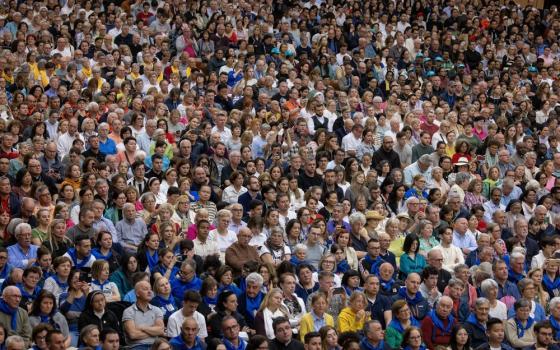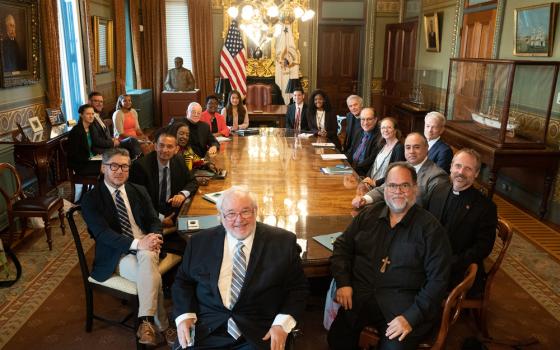While pundits fill the airwaves debating whether the American military surge in Iraq is working, another surge continues to unfold in Iraq and across the Islamic world, one potentially of far greater import for the 21st century: the emergence of Shi'a Islam as an emboldened force, from Lebanon on the Mediterranean coast all the way to Central Asia and the Indian subcontinent.
The rise of this "Shi'a crescent" deserves far more Catholic reflection than it's received, because Catholicism may be in a unique position to nudge Shi'ites toward reconciling their intense religious commitment with peace and pluralism.
According to the World Christian Database, there are 1.4 billion Muslims, with more than 80 percent belonging to the Sunni branch. Between 130 and 190 million are Shi'ites, mostly concentrated in the sensitive Persian Gulf region. Ninety percent of Iran's population of 70 million is Shi'ite, and Shi'ites are also a majority in Iraq, Bahrain, Yemen and Azerbaijan, and a plurality in Lebanon. There are Shi'a minorities in Afghanistan, Syria, Kuwait, Qatar, and several Central Asian nations, as well as Turkey, India and Pakistan.
Long considered a downtrodden and marginal subculture, viewed by many Sunnis as heretical, Shi'a today is drawing new strength from several forces: the fact that Iraq will likely become the first modern Arab nation to be led by Shi'ites; the success of Hezbollah against Israel, led by charismatic Shi'ite cleric Hasan Nasrallah; and the growing power of Iran. Some analysts report new evangelical energies among Shi'ites, producing conversions in Sunni strongholds such as Egypt, Jordan, Syria, Sudan, Algeria, and Morocco.
Shi'a Islam is usually viewed with alarm in the West, due largely to memories of the Iranian Revolution coupled with the anti-Semitic and anti-Western screeds of President Mahmoud Ahmadinejad of Iran. Yet Ahmadinejad is only one voice on a complex Shi'a spectrum, which also includes figures such as Grand Ayatollah Ali al-Sistani of Iraq, nominated by Iraqi Christians in 2005 for the Nobel Peace Prize. Experts say the Shi'a world today is gripped by an intense intellectual ferment, the outcome of which is wide open.
Over the years, Catholic-Muslim relations have tended to focus on Sunnis. Yet in some ways it's an odd match; with their low-church view of clergy, congregationalist models of community life, and sola scriptura approach to the Qur'an, Sunnis often resemble Calvinists more than Catholics.
On the other hand, Iranian author Vali Nasr in his 2006 book The Shia Revival ticks off an impressive string of parallels between Shi'a and Catholicism: a strong emphasis on clerical authority; an approach to the Qur'an accenting both scripture and tradition; a deep mystical streak; devotion to a holy family (in the case of Shi'ites, the blood relatives of Muhammad) and to saints (the Twelve Imams); a theology of sacrifice and atonement through the death of Hussein, the son of Muhammad's cousin Ali, who was martyred in Karbala, Iraq, in 680; belief in free will (as opposed to the Sunni doctrine of pre-destination); holy days, pilgrimages, and healing shrines; intercessory prayer; and strongly emotional forms of popular devotion, especially the festival of Ashoura commemorating Hussein's death.
Next Wednesday, Aug. 22, CNN will broadcast "God's Muslim Warriors," part of a series on fundamentalism by Christiane Amanpour. The documentary features colorful footage of the Ashoura rituals in Iran, and Catholics will have little trouble spotting parallels with Holy Week devotions in various parts of the world.
Nasr compares a Shi'ite pilgrim in Karbala to a Catholic at the shrine of Our Lady of Guadalupe in Mexico. He also writes that the mosque of Jamkaran on the outskirts of the holy city of Qom in Iran, where Shi'ites believe the legendary Twelfth Imam once appeared, plays a role similar to Fatima in Catholicism.
Another Iranian author, Reza Aslan, says that rational interpretation of Islamic law by Shi'ite clergy potentially creates a flexibility sometimes lacking in Sunni Islam, which is shackled to a more literal reading of the Qur'an. Aslan believes Shi'a-influenced societies may be more amenable to experimentation with democracy, human rights and pluralism, provided they're grounded in religious reasoning -- as, for example, in Catholic social theory.
All this creates fertile ground for Catholic-Shi'a exchange. Catholicism also has a presence in Shi'a societies that predates the rise of either Islam or the West; Maronite Catholics in Lebanon, for example, Chaldean Catholics in Iraq, as well as Armenian and Chaldean Catholics in Iran. These Catholics speak the languages and know the cultures.
To be sure, the decimation of the Christian community in Iraq offers a sobering caution against romanticism about dialogue. By conventional estimates, Iraq's Christian population, once among the largest in any Arab nation, has been cut in half due to violence and harassment from Islamic radicals, both Sunni and Shi'ite.
Outreach to Shi'ites doesn't mean Catholics should go silent about anti-Christian persecution, or that the church should abandon contacts with Sunnis. It does suggest more systematic efforts to forge ties with Shi'ite leaders, activists and movements, and to resist the Western tendency to see all Shi'ites through prism of radical Iraqi cleric Muqtada al-Sadr, or Iran's Revolutionary Guard. For example, Catholics could promote exchanges with Shi'ite institutions in Najaf, Iraq, long seen as a moderate alternative to Qom for leadership in the Shi'a world. Rising oil revenues in Iran mean Qom is flush, while instability in Iraq has devastated Najaf. (Four senior aides to Al-Sistani have been shot or stabbed just since July.)
Though the struggle for the soul of Islam is one Muslims must resolve for themselves, in a globalized world no community's internal debates are completely detached from surrounding influences. In this regard, history seems to be opening a special door for Catholicism, and much may depend on whether church leaders and grassroots activists alike walk through it.
* * *
Last week I addressed Pope Benedict XVI's early July motu proprio authorizing wider use of the pre-Vatican Latin Mass, and specifically ongoing debate about the prayer for the conversion of the Jews in the Good Friday liturgy.
Some readers wrote in to argue that the debate is academic, because the motu proprio prohibits celebration of the old rite, often called the 1962 Missal, during Holy Week. If that were true, no one would ever hear the disputed prayers.
In fact, it's not true, though it's easy to see how one might get that impression.
Article 2 of the motu proprio deals with private celebration. It authorizes priests to use the '62 Missal whenever they like, except during the Sacred Triduum, meaning Holy Thursday, Good Friday, and Holy Saturday. Article 5, however, deals with public celebration of the '62 Missal in a parish with a "stable group" of people who request it. This section places no restriction on celebration during Holy Week; the only limit is that on Sundays and feast days there's to be only one such Mass. In other words, the ban during Holy Week applies only to private celebrations. Public liturgies are permitted.
"There is no doubt that the motu proprio permits public celebration of the '62 Missal during Holy Week in parishes with a stable group of faithful," said Msgr. James Moroney, executive director of the Secretariat for the Liturgy for the United States Conference of Catholic Bishops.
The bottom line is that the prayer for the conversion of Jews, whatever one makes of it, will be heard during Holy Week in parishes that use the '62 Missal under Benedict's motu proprio, just as it has been since the more limited permission given by Pope John Paul II in 1984.
This is not to say, however, that all questions about the motu proprio have been answered. Members of the Bishops' Committee for the Liturgy in the United States recently met to discuss matters that are still up in the air, and sometime soon Bishop Donald Trautman of Erie, Pennsylvania, the committee chair, will send a letter to American bishops summarizing where things stand.
One outstanding question being raised by some bishops and canon lawyers is whether rulings over the years that apply to post-Vatican II liturgies should apply to the '62 Missal as well. The pope's motu proprio says the '62 Missal was never abrogated, but it doesn't spell out the status of subsequent disciplinary law. For example, can a vigil Mass be celebrated according to the '62 Missal on Saturday evening? Can communion be administered under both species? (In the old rite, only the consecrated Host is distributed, and only on the tongue.) Can altar girls as well as boys serve Mass?
What about scripture readings in the vernacular? Some communities that celebrate the older Mass have adopted the custom of proclaiming the reading first in Latin toward the altar, then turning around and reading it in the vernacular for the congregation prior to the homily -- an option not technically given in the Missal. Will that practice, or something like it, be sanctioned?
In general, sources say, these are not issues that can be resolved on the local level. Instead, they will probably be submitted in the form of dubia, meaning "doubts," to the Vatican for clarification.
The e-mail address for John L. Allen Jr. is jallen@ncronline.org







